Marktech Optoelectronics
3 Northway Lane North
Latham, NY 12110
Fax: +1-785-4725
Email: in**@ma**********.com
The broadest line of both silicon and InGaAs detectors commercially available.
Indium Gallium Arsenide (InGaAs) PIN photodiodes are made using InGaAs/InP technology.
Cutting-edge silicon photodetectors that excel in precise detection of light ranging in wavelength from 250nm to 1100nm
Monolithic “quads” or quadrant photodiodes (QPDs) are 2 X 2 photodiode arrays with four planar diffused photodiode elements or segments.
Marktech offers a broad line of silicon photo Transistors in a variety of package types ranging from miniature metal can to ceramic packages.
Our High-Reliability Photoreflectors are sensors that contain both the LED emitter and photodetector functions within a single package.
Marktech Si APD’s offer low-level light and short pulse detections of wavelengths between 400 nm and 1100 nm.
UV detectors are offered in a variety of TO metal-can type packages from TO-18 to TO-39 with special UV glass lens to insure optimum lifetime and the least amount of material degradation
With the ability to detect light in the UV, visible, and infrared spectrums, photo detectors, photo transistors, and photodiodes are being used in increasingly more applications.
Marktech offers the broadest range of emitters commercially available ranging from 235nm to 4300nm across the UV, visible, NIR, SWIR, and MWIR spectral ranges.
Marktech offers the broadest range of UV LEDs commercially available ranging from 235nm to 400nm including UVA, UVB, UVC, and deep UVC LEDs.
Our advanced line of visible LED products is engineered to deliver high-quality, energy-efficient lighting solutions across various applications from 400nm to 700nm..
Our NIR LED wavelength range is typically from 700nm to 1000nm, extending into wavelengths invisible to the human eye but crucial for numerous technological and scientific applications.
Our standard product offering includes wavelengths from 1020nm to 3000nm and operating currents ranging from 20mA to 350mA for high-power applications.
Our Point Source LEDs are specifically engineered for optical encoders, edge sensors, and other critical applications that demand highly focused light with minimal dispersion.
Multi-LED chips in a single package, our multiple wavelength LEDs are engineered to address a myriad of applications across the UV, visible, NIR, SWIR, and MWIR spectral ranges
Designed to produce a highly defined red dot or reticle, facilitating accurate aiming without revealing the location to the target.
Ideally suited for applications including edge sensing, line sensing, coin bill validation, and bar code reading
Our panels are crafted to deliver uniform, vibrant illumination across a wide range of applications, from consumer electronics to industrial displays.
Crafted with the latest LED technology, these rings provide adjustable illumination to meet specific needs, ensuring optimal visibility and enhancing the quality of your projects.
As a proud CREE LED Solution Provider for over a decade, Marktech offers comprehensive engineering support, including design, binning, and material selection, alongside custom packaging options for specialized applications.
CREE LED through-hole emitters, designed for high-temperature and moisture environments with UV-resistant optical-grade epoxy, offer a range of colors for versatile applications in signage and lighting.
CREE High Brightness (HB) SMD LEDs are the brightest, most reliable architectural, video, signage, scoreboard, roadway, and specialty LEDs available today.
CREE LED’s P4 series represents a leap in LED design, combining efficiency with aesthetic versatility to meet the demands of modern lighting applications.
Marktech’s CREE LED XLamp® offerings on aluminum core starboards simplify LED integration for designers, providing a range of colors and angles on compact boards for easy testing and implementation in varied lighting applications.
Marktech Optoelectronics introduces its new product line of CREE LED die, including the EZ1350 Series Die, packaged in TO-cans (TO-18 and TO-39 outlines) designed for precision and reliability in demanding applications with protection against environmental factors like moisture and dust.
Marktech Optoelectronics combines over 40 years of expertise in optoelectronics with a focus on customized engineering solutions, addressing specific customer needs and applications.
Custom photodiode detectors are designed to meet unique customer requirements, offering specialized performance features and cost savings through optimizations such as integrated filters, photodiode arrays, and hybridization.
Through our vertically integrated manufacturing facilities in California and Japan, we offer custom LED solutions, including packaging and optoelectrical categorization, enhancing product design and market readiness.
Multiple LED dies combined in a single package are engineered to address various applications across the UV, visible, NIR, SWIR, and MWIR spectral ranges.
To succeed, you need the exact optoelectronic package custom-designed and manufactured for your application, including hermetic metal SMD, TO-can, plastic SMD, and molded through-hole packaging.
Made-to-order semiconductor chips (die) and wafers are designed and fabricated to fit your needs. Standard dies are available in specific wavelengths for high-volume production applications.
Bare and encapsulated LEDs, photodiodes, and other components are assembled on FR4, metal-cored, and flexible circuit boards, ready for production.
Learn about the latest trends, devices, and potential applications.
The latest news and announcements from Marktech Optoelectronics.
Detailed information about common uses for Marktech Optoelectronics devices.
In depth discussions on LEDs, Detectors and the science behind them.
Become familiar with common terminology and concepts for LED Devices.
List of common concepts and definitions for Photodiodes.
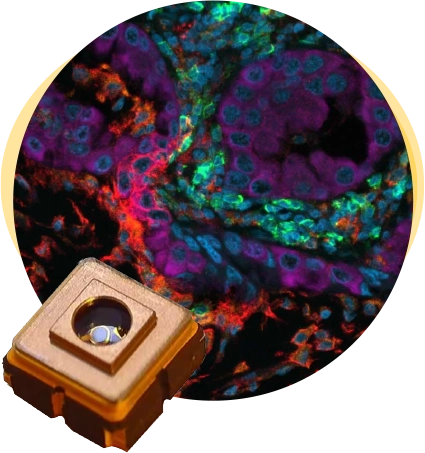
Custom packaging and hybridization of photodiode products offer further differentiation. Hybrid photodetectors have additional devices within the same package, such as amplifiers, thermoelectric coolers, and other electronics. A design with an amplifier within the detector package reduces noise in the system compared to a system with the amplifier on the circuit board because the amplifier magnifies the noise generated in the conductor from the detector to the amplifier. Photodiodes with integral thermoelectric coolers (TECs) create less noise and have higher signal-to-noise (S/N) characteristics.

Marktech provides the designer with insights concerning custom variations that optimize electrical, optical, and thermal characteristics without requiring significant volume commitments. In addition to our headquarters in New York, where we have both our design engineering staff and complete testing department for all optical and electrical parameters, we also have two manufacturing facilities in California and Japan. Marktech is a vertically integrated company that allows us to produce detector components quickly, thus decreasing your time to market. We can even make your entire package in the United States.
Photodetectors are sensors that detect light and convert the photons into measurable currents. They are, therefore, useful for applications ranging from water faucets to nuclear transient events. With varied technologies and packaging, specific measurements can be made that are ideal for your applications.
Marktech devices are solely solid-state devices called photodiodes. Our product line has no photomultiplier tubes, although our products, such as avalanche photodiodes, may supply similar functionality. Response rates can be as fast as 300 picoseconds. Light levels that can be measured range from tens of photons to massive levels. Wavelengths detected can range across the deep UVC, UVB, UVA, Visible, NIR, SWIR, and MWIR spectra (less than 250nm to greater than 4000nm).
Each photodetector uses a p-n or p-i-n junction as part of either a photodiode or phototransistor construction, effectively working as an inverse function of a light-emitting diode’s typical operation. The detectors provide a current response to specific light wavelength ranges depending on the technology used.
Detector Materials and Characteristics: The materials used may be silicon carbide (Deep UVC detectors), silicon (UV to NIR detectors), or InGaAs (Visible to SWIR detectors). The wafer materials’ P and N epitaxial layers can be optimized for specific customer specifications and desired characteristics, including Minimum Reflection, Low Dark Current, Minimum Series Resistance, Low Capacitance, Fast Response, Low Cross Talk, and more. The detectors can be packaged in various packages, from metal cans and standard 3mm and 5mm plastic packages to surface-mount…or virtually any custom package assembly. Detector applications range from simple door openers to the latest cancer PET scan system.
Detector Spectral Ranges – Wavelengths Detected: Available Marktech can provide photodiode detectors capable of detecting from deep UVC to SWIR or wavelengths from 235nm to 2600nm. Marktech can optimize detector sensitivities and spectral ranges, providing process-controlled uniform product solutions.
Some products are also available in epitaxial or epi wafer forms and can be packaged as photoreflectors, arrays, and hybrid parts. For a part listing and additional information, see All Detectors
Marktech’s silicon phototransistors can be utilized in applications requiring very high sensitivity, uniform response, and increased reliability for applications that require very high sensitivity, uniform response, and increased reliability, such as card readers and optical sensors.
The photovoltaic silicon photodetectors have a spectral sensitivity from near ultraviolet, through the visible range, to short wavelength infrared (250nm to 1100nm). These are used in medical, analytical, communications, spectroscopy equipment, and sensing, requiring broadband sensitivity with enhancements in the blue/green region. These devices can exhibit moderate-speed response, high sensitivity, and low noise. Devices are available as either phototransistors or photodiodes.
The Photoconductive silicon photodetectors are suitable for high-speed and high-sensitivity applications. Their spectral range extends from 350 to 1100 nm, making these photodiodes ideal for visible and near-IR applications, including AC applications such as detecting pulsed LASER sources and LEDs.
Marktech’s broad line of silicon photodetectors is provided in a variety of package types, ranging from through-hole plastic, ceramic, metal-can, surface mount, and complete custom. These devices are available with standard silicon die with a spectral sensitivity of approximately 400 – 1100nm or special UV-enhanced silicon chips with sensitivity in the lower UV-A range. Custom active areas and multi-element chips can also be manufactured to suit your application. Many of our wafers/chips are manufactured in the USA and optimized to ensure uniform and consistent performance with high reliability. These devices are well suited for visible and near IR applications requiring high speed, high sensitivity, and low noise, such as optical switches and optical communications.
Marktech silicon detectors can be obtained with integrated filters for reduced visible light interference or optimized for your required spectral range. In addition to our various package styles available off-the-shelf, Marktech can integrate multiple detectors and emitter detector combinations in a single package type.
Medical, Optical Communications, Industrial, Scientific, and Analytical.
Remote Controls, Optical Encoders, Position Sensors, Fiber optics, Bar code readers and chemical analysis
Avalanche photodiodes are ideal for high-speed and low-light-level detection in the near-infrared range. These detectors have become the semiconductor equivalent of photomultipliers in many applications, including data communication, LIDAR, instrumentation, and photon counting. In addition, cost-effective customization of these APDs is offered to meet exacting design specifications. Operation voltage selection and breakdown voltage (Vbr) binning, wavelength-specific band-pass filtering, and hybridization options are among many application-specific solutions available at Marktech.
Marktech APDs have an internal gain mechanism, fast time response, low dark current, and high sensitivity in the near-infrared region. These APDs are recommended for applications that require high bandwidth or where internal gain is needed to overcome high pre-amp noise. In addition, Marktech APDs provide higher sensitivity than a standard photodiode and are ideal for extreme low-level light detection and short pulse detection. APDs are essentially photodetectors that provide an amplification gain stage through avalanche multiplication. They are similar to photomultipliers but are solid-state semiconductor devices.
Silicon Avalanche photodiodes (Si APDs) are the preferred optical detectors for applications where the wavelength lies between 400nm and 1100nm (with 800 and 905nm optimized sensitivities) and exhibit high speed and low noise for visible to near IR applications. Standard versions are available in three active area diameter sizes, 200, 500 & 800um, and are offered in hermetic TO Cans and can also be supplied in cost-effective LCC packages.
TUV Detectors (250nm – 450nm)
UV LEDs/emitters are becoming more prevalent in the industry, replacing old technology such as mercury lamps. As a result, the need for UV detection is also increasing. Marktech offers new UV-enhanced Silicon-based UV detectors in various metal-can thru-hole type packages ranging from TO-18 – TO-39 with special UV glass to ensure optimum lifetime and the least amount of material degradation. In addition, we will be introducing a new hermetically sealed surface mount package with a glass cover for those applications requiring low profile and high reliability. These new “seam welded” devices will be available in production in the first quarter of 2021. Marktech offers standard and custom package solutions in a bare chip, component, or assembly form to meet your application requirements.
Marktech UV detectors offer superior stability over time and high device sensitivity with low dark current.
Medical, Industrial, Scientific and Analytical, Environmental/Ecological and Commercial.
Biomedical/chemical analysis, UV emitter output monitoring, UV sensors, spectrometers, and wearables.
These two high-sensitivity and high-reliability product series are ideally suited for applications in analytical instruments, medical diagnostics, and communication devices in the SWIR (short wavelength infra-red) wavelength range.
Photodiode chip active area sizes from 0.1mm to 3.0mm are available to provide the optimum balance between low dark current, high speed, and light sensitivity. This allows for increased flexibility and options in a variety of applications, from fiber optics and high-speed optical communications to medical and chemical analysis.
None of our PIN photodiodes utilizes integrated TE (Thermal Electric) Cooling, thereby reducing costs and improving overall efficiency.
In addition to PIN Photodiodes, Marktech offers foundry services for epitaxial growth of SWIR wafers in the 1.0 um to 2.6um range, using InP material as the base substrate. Marktech is currently producing these high-reliability wafers in 2″, 3″ and 4″ diameters. Among the applications for these wafers are photodetectors, linear arrays, and image sensors. Photodetectors processed using our epitaxial wafers provide significant advantages, including lower dark current, better shunt resistance, and improved performance at lower operating temperatures.
Marktech-manufactured InP PIN Photodiodes using InGaAs/InP technology have a spectral sensitivity in the 800 to 1750nm range for applications requiring low dark current, high speed, and sensitivity, such as fiber optics and optical communications. Marktech’s detector die can be placed in various packages, from metal can TO-5, TO-18, and TO-46 to surface mount and standard 3mm and 5mm plastic packages. We can also incorporate the detector die in custom-designed assemblies.
Marktech Optoelectronics is one of only a handful of manufacturers that supply emitters and detectors in the extended wavelength or SWIR range. Marktech’s can package UV, visible, NIR, and SWIR LEDs together with InGaAs, silicon, and silicon carbide photodiodes to provide detection amd emission source in a single package.
Marktech’s standard product offering includes through-hole and surface mount packages with wavelengths from up to 2600nm and operating currents ranging from 20mA to 350mA for high-power applications. Higher wavelength ranges up to 3000nm are available in specific package types (see MWIR below).
The SWIR wavelength range requires specialized optical detectors since standard silicon detectors have a maximum sensitivity limit of up to only approximately 1100nm. Marktech produces a line of InGaAs detectors optimized for sensing light in this SWIR wavelength range. These detectors can be obtained as individual, discrete components or combined with a silicon sensor to cover the complete spectrum of light from the visible to the SWIR range. Marktech also offers the option to custom-produce multi-element devices with emitter and detector chips in the same package.
Marktech also provide InGaAs APDs for visible, NIR, and SWIR applications requiring infrared detectors with higher sensitivity than InGaAs PIN photodiodes. We can also provide InGaAs APD photodiode arrays on a custom basis.
The Marktech extended wavelength standard SWIR package offerings include:
Extended wavelength detectors: If you require above 3000nm, which is more in the MWIR [mid-wavelength infrared] range, Marktech has a team of experienced engineers to work with you to develop a custom wafer or die that meets your specific application needs.
Marktech’s optoelectronic manufacturing and assembly capabilities include:

Arrays of SWIR detectors have been utilized in SWIR night vision systems, which rely on the intense night glow to illuminate the scenery even when the visible spectrum is completely dark.
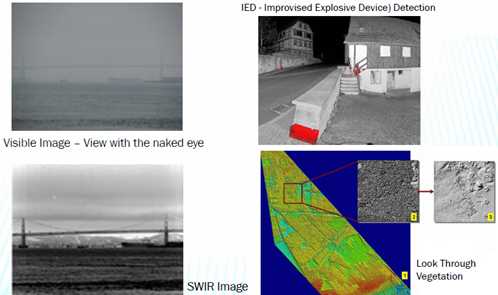
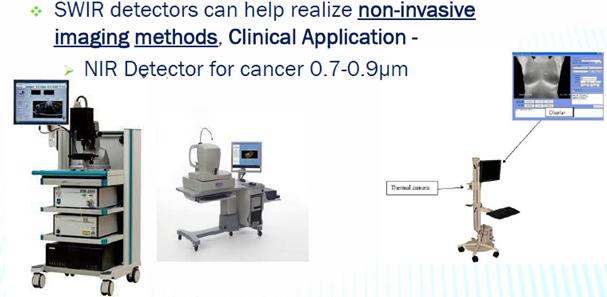
Arrays of SWIR detectors have been utilized in SWIR night vision systems, which rely on the intense night glow to illuminate the scenery even when the visible spectrum is completely dark.
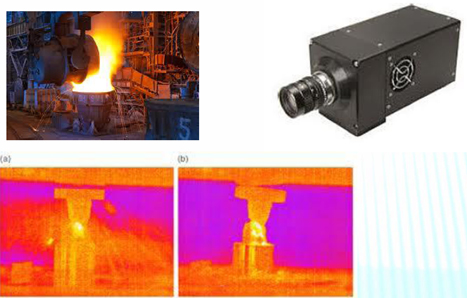
Inspection of High-Temperature Manufacturing Processes
Web inspection of continuous processes such as high-temperature manufacturing processes and quality controls.

SWIR can be used in the recycled plastics industry due to the C-H, O-H, and N-H found in plastics, and the wavelength used is around 1.0-2.2μm.

SWIR detectors, such as 1240nm, 1640nm, and 2130nm, combined with visible detectors can be applied in some remote sensors for soil moisture and agricultural drought monitoring.
SWIR imaging can better provide more information about Rock and Soil features than visible images due to the reflection characteristics of rock and soil in the 1.8 – 2.5um region.

LIDAR (Light Detection and Ranging) is a surveying method that measures distance to a target by illuminating that target with a laser light. LIDAR uses laser light pulses, while radar uses radio waves. Avalanche Photodiodes enable the LIDAR application as a remote sensing technology that optically measures properties of scattered light to find the range and other information of a distant target.
Let us help select the perfect parts and services to make your application come to life.
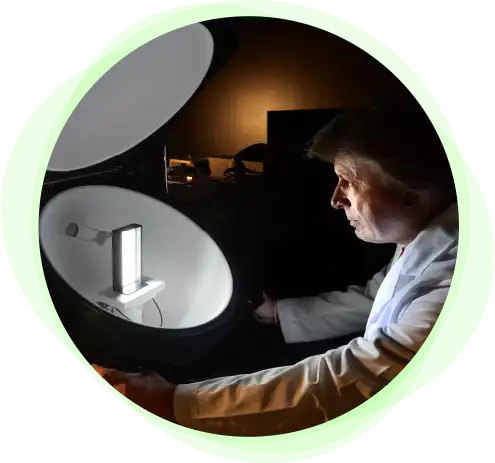
Do you need a small number of LEDs for your proof of concept? Or, are you looking to purchase a run for your prototypes? Visit our online stores at Digi-Key Electronics and Mouser Electronics today. In Japan, our products are now available through Rikei Corporation. In Israel, our products are now available through Militram. In Canada, our products are now available through ARL Group.
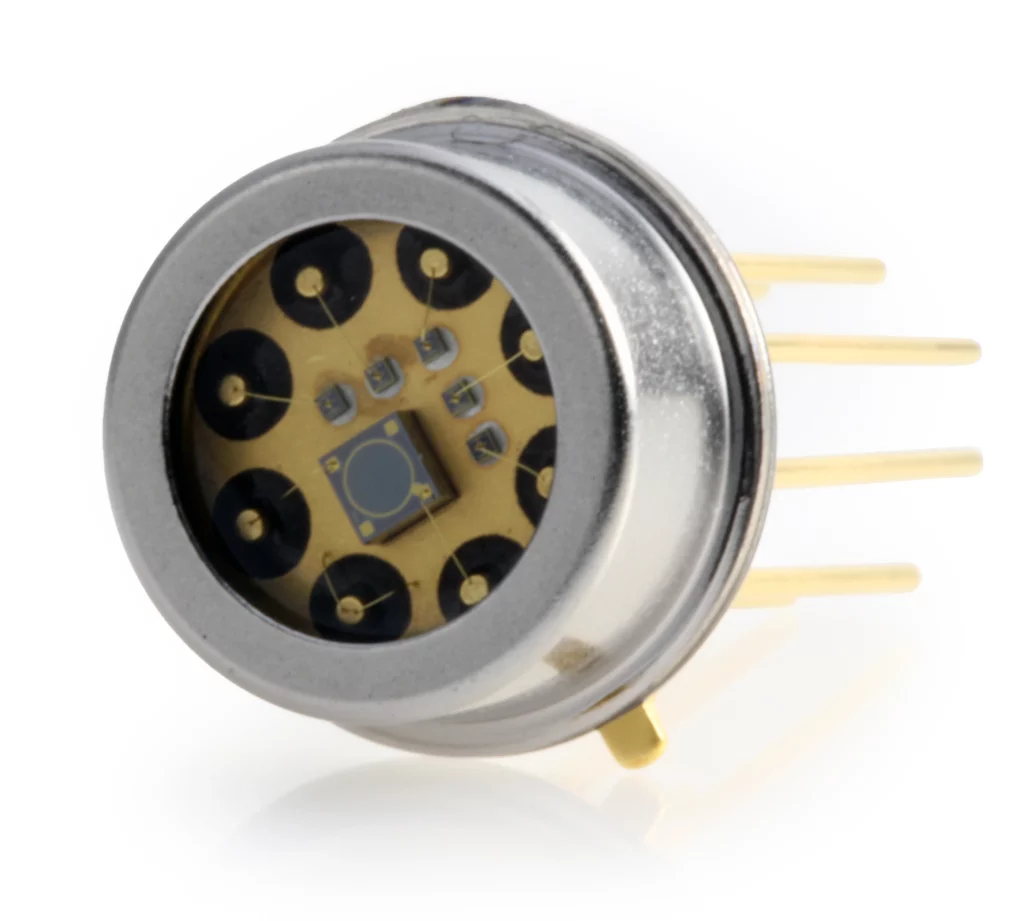

As our industry constantly changes and evolves, Marktech has been there since the start. Stay on top of new and upcoming technology trends, industry news and new product offerings.
Marktech Optoelectronics
3 Northway Lane North
Latham, NY 12110
Fax: +1-785-4725
Email: in**@ma**********.com